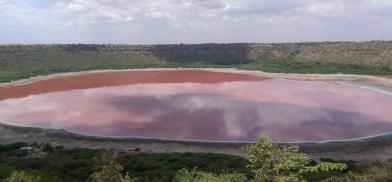Maharashtra's Lonar Lake dons baby-pink colour, astounds scientists
For the past four days or so, Maharashtra's world-famous Lonar Lake, that was supposed to have been formed by a meteorite hit, has mysteriously changed colour from its normal bluish-green to a baby-pink shade

For the past four days or so, Maharashtra's world-famous Lonar Lake, that was supposed to have been formed by a meteorite hit, has mysteriously changed colour from its normal bluish-green to a baby-pink shade. The sudden colour change has come after over two decades when it had similarly changed its hue to reddish-pink.
"We have discussed it with our teams here and sent the lake water samples for analysis to the NEERI and other institutions... The exact reason for this phenomenon will be available after their reports come," Buldhana Collector Suman R. Chandra told IANS.
Terming it as a wonder of nature', Chandra said it appears to be an algae bloom primarily, but microbiologists could tell better.
Lonar Tehsildar Saipan Nadaf said local old-timers and records indicate a similar change in colour around 2000, but it did not grab much attention then.
Situated inside the small Lonar Sanctuary, it is renowned globally as the largest basaltic impact crater on the planet, created around 57,000 years ago, with 78-hectare lake's water unique on Earth for its dual salt and alkaline qualities.
Though it has found mention in ancient Indian and Mughal texts like Skanda Purana, Padma Purana and Ain-i-Akbari, it was discovered' 197 years ago - by a European J. E. Alexander in 1823.
Though in a remote location around 500 kms east of Mumbai, Lonar Lake now attracts around 400,000 tourists annually, besides scientists, from around the world.
Quoting tentative opinions by experts, Nadaf said that in the summer months, the water level recedes, increasing its salinity and alkaline properties.
"This is apparently loved by the Dunaliella Algae which abounds here which turns into a reddish-pink colour. However, on June 10, there was around 3.3 cm rainfall in the vicinity and today (June 11), the colour has receded to its normal bluish-green shade at least one-metre away from the shores as fresh water flowed into the lake," Nadaf told IANS.
Another unique aspect was in February when a couple of pink Flamingos made the Lonar Lake its home for a fortnight, gobbling on the lake algae.
Usually, these avian migrants are visible in this region around early winter, and in huge numbers in Mumbai after January, said Nadaf.
Nestling in the Deccan Plateau Lonar Lake has a mean diameter of 1.2 kms, the rim is around 1.8 kms and the 150 metre deep water body rests around 140 metres below the rim, making it a popular trekking location.
It was created by a high-velocity - around 90,000 kmph - impact of a meteor or an asteroid colliding with Earth, but the lake has no marine life barring some species of algae, and has no oxygen below one metre, though the surrounding sanctuary abounds in plant and animal life.
Experts from the Geological Survey of India, Smithsonian Institution, US Geological Survey and scientists from other global universities have been conducting extensive studies here and Biological Nitrogen fixation was discovered in the lake in 2007.
An IIT-Bombay study revealed that the minerals in the Lonar Lake soil are very similar to those found in the rocks from Moon brought back during the Apollo Program.
The Maharashtra Tourism Development Corporation hailed the unique marvel of nature by putting up photos: "From Green to Pink: Lonar Crater Lake has changed its colour."








Post a Comment